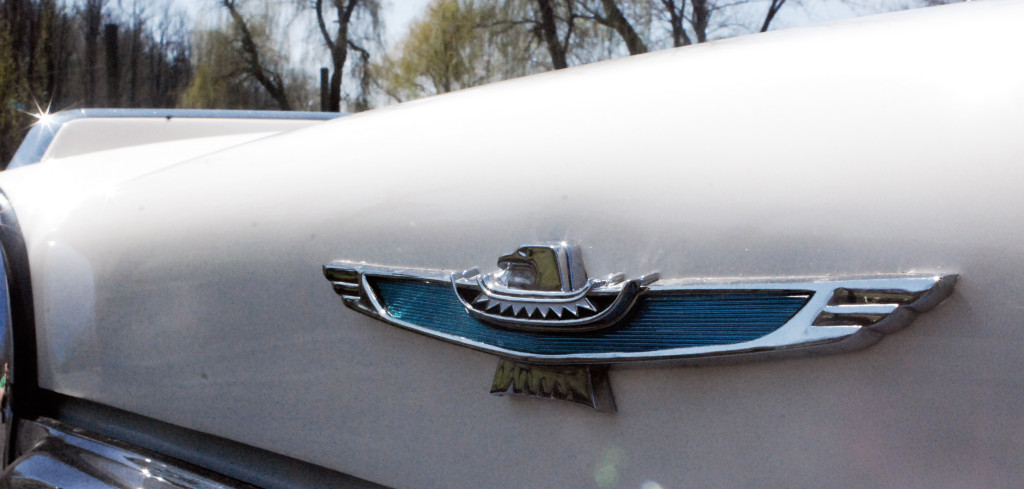
1955
In 1955 Ford dealers gained their first-ever companion model for the selling season. They had no idea the impact this car would have on the auto industry and on the public. It began a pulse that continues forty years later…this, of course, was the two-passenger Thunderbird, a sleek, sporty, wildly inventive design in a “personal” car.
The Thunderbird design came from the styling genius of Franklin Q. Hershey and Bill Boyer. He was the young man who had been doing sports car rendering since 1950, and who was hoping to convince management to put this new car design into production. However, nothing came of it until 1951, when then-general manager of Ford Division Lewis D. Crusoe was in Paris for the automobile show with George Walker, who was and outside consultant. Supported by Walker, Crusoe was both impressed and excited by what he saw in Paris – the Spanish Pegaso, the Bugatti, the Jaguar XK-120 and GM’s Le Sabre. Crusoe was reported to have asked Walker, “Why don’t we have something like that?” “Oh, but we do,” replied Walker, who then picked up the phone to call the people back home. The staff designers of both men began drawing ideas for the sports car of the future.
Robert S. McNamara, who was hired shortly after the war by Henry Ford II, was elevated to the position of general manager. His design and marketing influence at Ford would be felt long into the next decade. In 1955, competition between Ford and Chevy was fierce, especially with the production of GM’s Chevrolet Corvette. Ford’s response to this was the Thunderbird.
The production Thunderbird was the work of Hershey and Boyer. Renderings in clay models and steel prototypes led to the basic styling which gradually was refined until the final result was a timeless look; but the problem remained of what to call the new model.
Still lacking a name, and scheduled to make its appearance on Feb. 20, 1954 at the Detroit Auto Show, a contest was arranged to name the classy new two-seater. Some 300 possibilities were reviewed, such as Sportsman, Sportliner, Roadrunner, Arcturus, Barracuda, El Tigre, and Coronado.
The now-immortal label was the idea of stylist Alden R. Giberson. Brought up in the Southwest, Gib (as he was known) had a broad knowledge of the customs of the local Indian tribes and the lore of the Thunderbird. Unaware that a prize was being offered to whoever named the car, Gib earned himself a $250.00 suit. One problem arose when Gib went to claim his prize – in those days a $250 suit was not available in Detroit. Far beyond what the trade handled then, Gib finally settled on a $100.00 suit with two pairs of pants. Gib was also the designer of the Thunderbird emblem, a handsome turquoise and silver creation that embodied the best traditions of the American Southwest.
The first Thunderbird came off the line on September 9, 1954. A boulevard tourer rather than an all-out sports roadster, the Bird shunned snap-in side curtains for more convenient roll-up windows, fiberglass bodywork for traditional steel, and a six-cylinder engine for a potent V-8, a 292-cid Mercury engine derived from Ford’s 1954 Y-block. With 193 horsepower, the T-Bird had plenty of zip to go with its good looks, and the 1955 model sold a respectable 16,155.
In retrospect the two-seat Thunderbird was a fluke. Though it was a good idea, it didn’t, in the end, sell in sufficient volume to satisfy company accounts or Robert S. McNamara. Because of that, it was made into something entirely different – the post-1957 “Squarebird” with four seats. Interestingly, the change was underway even as the first two-seaters were being sold. Given the industry’s normal three-year new-model lead time, it is clear that forward planning for a four-seater had to have begun no later than 1955. Though the two-seat Birds sold well, their volume was never enough to impress management, and was never as high as that of the later four-seat cars. As almost everyone knows now, the “classic” two-seat 1955-57 Thunderbirds are highly prized – and high priced – collector cars.
1956
The most marked difference in the ’56 Thunderbird was its new “continental” style exterior spare tire mount. This last minute change was likely made more as a way to increase trunk space than for styling, though it did come off well visually. The front fenders now sported flip-open cowl ventilators, to answer complaints of excessive engine heat in the ’55 cockpit. Another appearance fillip that came off well was the now-famous porthole windows, a new option for the hardtop. Though the round shape didn’t relate to anything else on the car, it somehow looked right. More important, it improved over-the-shoulder visibility. Whether it was because of that or their slightly nautical air, the portholes were preferred by buyers four to one over the blind-quarters hardtop. Standard T-Bird power remained the 292V-8, now rated at 202bhp with manual transmission, and the new 312 engine was added as an option. Despite its expected disadvantages as a competition car, the Thunderbird was raced, and at the 1955 Daytona Beach Speed Weeks, a T-Bird sponsored by Tom McCahill swept all honors among American production sports cars. Thunderbird output trailed off slightly to 15,631, perhaps the result of slightly higher pricing.
1957
Certainly a big factor in Ford’s popularity this year was one of the industry’s broadest lines of powerplants. Starting at the bottom was the ohv six, the base engine in the standard Fords. The V-8 offerings began with the 190 bhp 272, then jumped to a 212-bhp 292 engine, the latter standard Thunderbird powerplant. Then came a raft of 312 V-8s, commencing with a four-barrel 245-bhp version, and extending through twin four-barrel 270- and 285-bhp units. Finally, there were two supercharged 312s, rated at 300- and 340-bhp on 8.5:1 compression. It is doubtful any of the latter were actually built, but some 208 of the 300-bhp engines did find their way into Thunderbirds this year.
Rumors of a new, larger Thunderbird started circulating in 1957. Some people suspected the two-seater was on the way out, while others hoped it would continue. A serious face-lift was mandated for 1957. The front wore a bold combination bumper/grille, an idea Bill Boyer had proposed for 1955 that was then considered too radical. The back end sprouted modest tailfins and the trunk was extended, largely to get rid of the spare tire; but the 1957 Thunderbird was nevertheless four inches shorter than the 1956, thanks to the spare’s reabsorption into the trunk. An optional exterior spare tire was listed for ’57 and some models were so equipped. Inside was a handsomely redesigned dash with a telescopically adjustable steering column, a feature revived from the 1955 model, and the door panel trim was modified and featured a repeating Thunderbird logo.
The 1957 was the most styled of the three-year two-seat generation. Still, Ford sales and product-planning personnel resisted stylists’ attempts to gook up the car with extra chrome, two-tone paint, and sheet metal creases. They deserve a lot of credit because what emerged looked good, and still looks good today. Production lasted longer than usual due to delayed release of the 1958 Thunderbird, so the 1957 set the two-seat sales record at 21,380 units.
